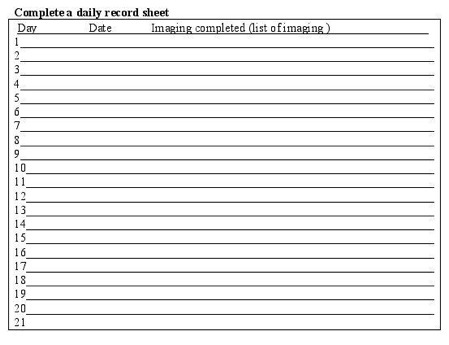Sports Psychology
Dr. Declan Aherne is a registered sports psychologist with the Irish Sports Council
Dr. Declan Aherne is a registered sports psychologist with the Irish Sports Council
Correcting your Negative Thoughts
 Instructions: Negative thoughts tend to be automatic and irrational and by challenging them and re-placing them we can learn to feel more confident in ourselves. In the left hand column below write in any negative thoughts you might have or have had. A negative thought is one that is self-critical or anxiety provoking.
Instructions: Negative thoughts tend to be automatic and irrational and by challenging them and re-placing them we can learn to feel more confident in ourselves. In the left hand column below write in any negative thoughts you might have or have had. A negative thought is one that is self-critical or anxiety provoking.
Give this thought a rating on a scale of 1 –10 where 1 = ‘I don’t believe at all’ and 10 = ‘I fully believe’.
In the second column write in the type of error in your thinking that is contained in this negative thought – using the list on the page attached.
In the final column construct a positive alternative statement to the negative thought. This positive thought needs to be carefully worded as a counter statement which you agree with and are willing to believe in.
Once more rate this statement on a scale of 1 to 10 as above. Through constant familiarisation with your typical negative thoughts and changing them into positive alternatives you will gradually develop a consistent positive outlook , no longer engaging in negative thought patterns.
The objective of this exercise is increase your belief ratings for the positive thought column while at the same time seeing a decrease in your belief rating the negative thought column. It is only by constant practice that this skill of positive thinking can be acquired.
You are advised to refer to it on a daily basis until such time as you feel the negative thoughts have been abandoned completely.
Positive Affirmations
In order to promote and maintain a positive  outlook it is essential that we get into the habit of speaking in a positive manner to ourselves. One helpful means of doing this is by practicing positive affirmations on a daily basis.
outlook it is essential that we get into the habit of speaking in a positive manner to ourselves. One helpful means of doing this is by practicing positive affirmations on a daily basis.
A positive affirmation is simply a statement that reflects our most positive and realistic wish and objective going forward. It is saying in words, what it is I want for the future, in terms of my performance and what I am going to do. It leaves no room for ambiguity or uncertainty.
It contains a message which I am willing to commit myself to fully. It is to be rational and attainable and the words used are to be positively construed. An affirmation is to be brief and to the point, personalised and meaningful to the individual who writes it.
You can write your affirmation on a card and place it in your wallet or next to your bed where it can be referred to on a daily basis and repeated at least 20 times per day. Make sure that your affirmation card is kept nicely and in a safe place.
Showing respect for this message of self-affirmation reflects the respect you have for your own self-worth.
Examples of affirmations which you might adapt and expand upon for yourself:
Please click here to download our Positivity Adapted PowerPoint Presentation
6 Week Training Programme
Introduction
Now that you have been introduced to the broad range of psychological skills required to optimise your playing performance, it is time to get down to practicing these skills. This training programme is no different to any other programme you have used to improve your game in the area of skills, strength, speed, etc. Practice makes perfect, but without practice there can be no change.
By adhering to this 6 week programme you will improve your skills level significantly and you will also have learnt strategies that will be of ongoing benefit to you for the rest of your playing career. You are asked to complete the attached schedule as you proceed through the programme.
The programme outlined has a menu of items to choose from. You may choose to do all or some of the items. This ought to be based on your assessment feedback which identifies areas of weakness or areas you wish to improve on.
‘Involves Total Absorption In The Task At Hand’
You must prepare to concentrate, don’t just expect it to happen.
We prepare at each training session as well as on the day of the match.
You will concentrate most effectively when your focus is specific, relevant and above all under your control.
Specifics for you to focus on are your specific involvement in set piece moves as well as your positive statements for the match.
Concentration loss occurs when you are paying attention to things that are in the future, out of your control and irrelevant to the task at hand.
Typical distractions occur after scoring, thinking of outcome rather than performance and noticing things off the pitch.
Anxiety decreases your concentration ability.
This is one of the reasons why we emphasize the importance of relaxation before and during a match.
Techniques
How to concentrate in Sport
To be practiced at training and to be put into action during matches, in particular at key points in game when concentration can lapse.
‘Seeing is Believing’
How It Works
Muscle memory, mental blueprint, mental set.
Your doing it anyway.
Uses Of Imagery
Key Considerations
Times To Practice Imagery
Methods Of Practicing
Uses
How To Imagine
Daily Imagery Training Programme.
10 minute sessions daily.
Choose from any number of the following menu of activities:
Goal Setting Guidelines
Common problems in setting goals:
Click here to download the “Goal Setting Review” paper.
Click here to download the “Goal Setting Review & Performance Evaluation” paper.
‘Mindfulness and Sport’ – The key to maximising your performance on the pitch
Key question: In both training and matches where is your attention?
To maximise your performance at any point in the game you need to be fully present to what you are doing. If you are only 90% present then you are only able to contribute 90%. Your goal ought to be 100% present. This is achieved by being aware / focusing on the here and now in all its formats.
The idea is that at any point in time you can bring yourself more into the present by noticing where your awareness is and ensuring it is based in one or more of the above areas as appropriate.
Practice
Click here to download the “Playing in the hear and now” document.
Game Evaluation
Click here to download the “Game Evaluation Form“.
Sports Psychology Intake Form
Click here to download the “Intake Form“.